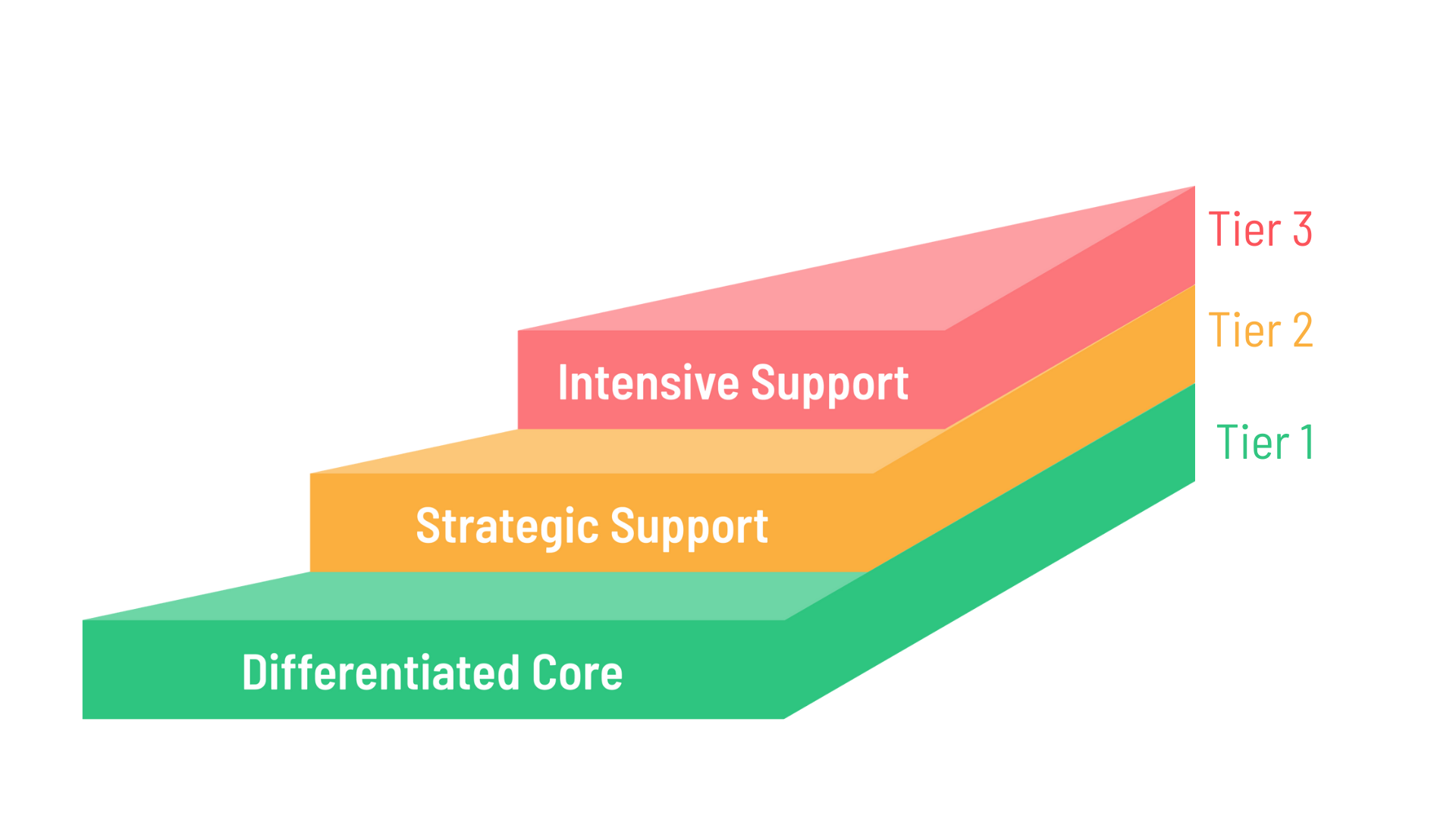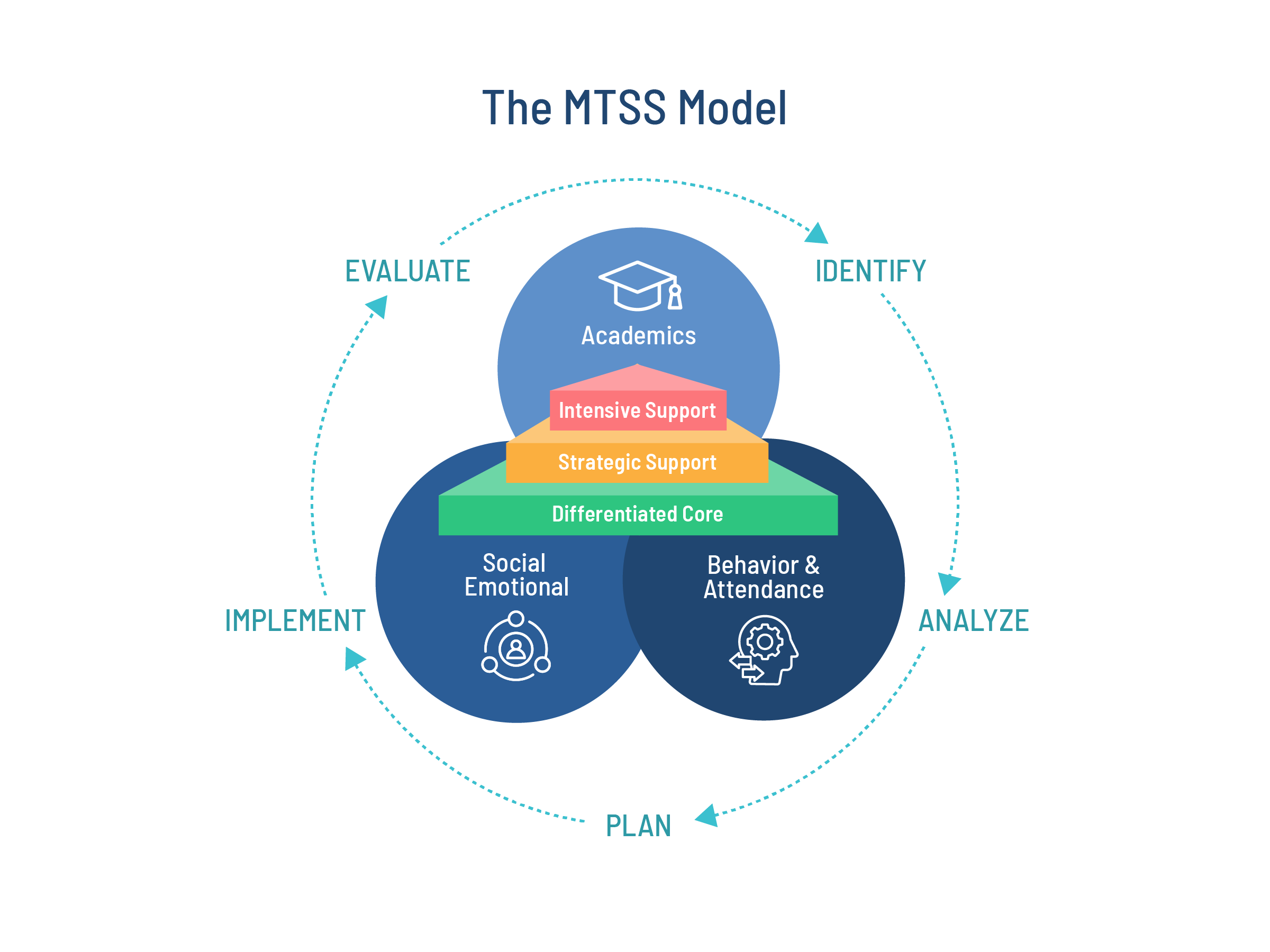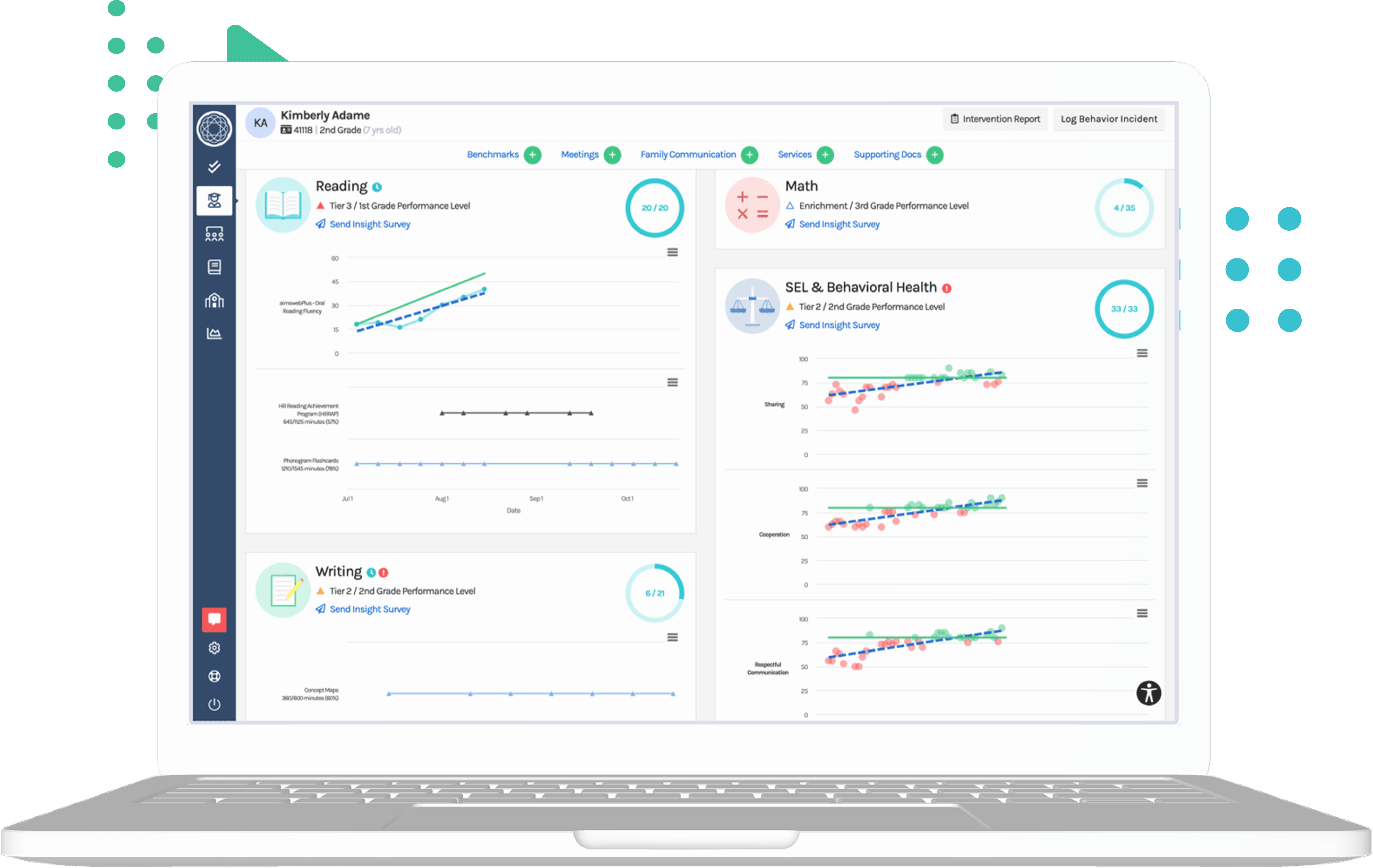From 2019 to 2024, 8th-grade math scores did not rise in any states, according to the National Assessment of Educational Progress, a large-scale assessment that measures the academic achievement of students in the United States, often referred to as “The Nation’s Report Card.” While federal pandemic aid played a key role in addressing learning loss, the expiration of ESSER funds has made it increasingly difficult to sustain and scale effective strategies like high-dosage tutoring and extended learning time. The reality is, many districts are facing the challenge of supporting students with fewer resources and increased demands. This blog will examine four key questions designed to guide and support your MTSS team as you implement math intervention. Let’s review the basics.
Math Intervention for MTSS: Key Takeaways
- Strong Tier 1 math instruction is essential for effective interventions.
- Use evidence-based strategies like explicit instruction, number talks, and manipulatives.
- Foster a growth mindset to boost student confidence in math.
Defining MTSS in Math
Math intervention is crucial for supporting students who struggle to grasp foundational math skills or require additional time and support to meet grade-level expectations. Without targeted intervention, these students can fall even further behind, lose confidence, and develop long-term gaps that negatively impact their academic success.
Math Intervention is Most Effective within a Multi-Tiered System of Support (MTSS)

The support is layered, meaning students receiving Tier 2 intervention also fully participate in Tier 1 core instruction. When intervention is implemented, the goal is not to reteach everything, but to strategically address unfinished learning, misconceptions, and fluency gaps so students can access grade-level content.
4 Questions to Get Your Team Started
#1. Is Your Team Implementing a Comprehensive System that Effectively Identifies Student Needs?
When identifying students who need support, use multiple data sources:
- Universal Screeners (e.g., iReady, MAP Growth, STAR Math)
- Diagnostic Tools (e.g., Number Sense Screeners, DIBELS Math)
- Classroom Assessments (e.g., exit tickets)
- Teacher Observations
Common signs a student needs math intervention:
- Difficulty with basic number sense (counting, comparing, composing/decomposing numbers)
- Inconsistent understanding of operations or place value
- Reliance on inefficient strategies (e.g., finger counting in upper grades)
- Avoidance, anxiety, or low engagement during math

Starting with math intervention alone may not address the root of a student’s challenges—examining the whole picture is essential. Consider all available data, including attendance, as research shows a strong correlation between chronic absenteeism and lower performance on NAEP assessments.
Resource:
#2. Is the Quality of Your Tier 1 Instruction Strong and Effective?
Are your schools utilizing high-quality Tier 1 curricular materials? Reports show only 20% of materials used in classrooms are standards-aligned. According to the TNTP Opportunity Myth, of the 180 classroom hours observed, 133 hours were NOT grade-level appropriate, only 44% of teachers expected their students could have success with the standards.
While most teachers supported the standards in theory, less than half believed they were right for their students. Many students enter college underprepared for coursework, often needing remedial classes to bridge the gap. To address this, we must set higher expectations for our students, beginning with the adoption of high-quality instructional materials.
Math Walks offer a valuable opportunity for teams of educators and leaders to observe effective practices and engage in collaborative professional growth. Once you have adopted high-quality standards-aligned math materials, “inspect what you expect.”
- Are the materials being used with fidelity?
- Are more rigorous, problem-based lessons being overlooked or replaced with primarily procedural instruction?
Creating a list of look-for's based on your math vision and the effective strategies embedded in your curriculum can help your team develop a clear, shared understanding of what high-quality classroom instruction should look like at your school. Without a strong Tier 1 instructional plan, efforts to support struggling students through intervention or acceleration will lack the foundation for lasting impact.
Tools to Select and Inspect Instructional Materials:
- Math Curriculum Selection & Implementation Checklist
- Math Walk Checklist
- Tier 1 Math Walk Rubric
- IPG (AchievetheCore.org)
#3. Are Your Interventions Effective?
Just as a doctor wouldn’t prescribe a medication that hasn’t been clinically tested and proven effective, we want to ensure that the interventions we use in our classroom are grounded in research and evidence. For many years, the “drill and kill” math strategy was thought to be an effective way to support learners struggling with math concepts. But, doesn’t this sound dangerous?
Research shows that developing math fluency as flexibility with numbers helps students deepen their understanding of underlying mathematical concepts, make meaningful connections, and build greater confidence in their abilities.
Gray & Tall (1994) found that high-achieving students used number sense and flexible strategies, like turning 19 + 7 into 20 + 6. Low-achieving students, however, relied on rigid, inefficient methods like counting backward. The researchers concluded these students struggled not due to lack of knowledge but because they were taught to memorize procedures instead of understanding and working flexibly with numbers, leading to a harder, less effective mathematical path. (Source)
Research shows that poor number sense is a key reason students struggle with algebra (Feikes & Schwingendorf, 2008). Educators need effective intervention strategies that build numerical flexibility and deepen understanding of the math concepts behind procedures.
Number Talks are a powerful tool that helps students develop flexible thinking about numbers while deepening their understanding by making connections across strategies. In addition, building opportunities for students to visually represent math concepts helps strengthen their conceptual understanding, supports diverse learning styles, and enables them to see the relationships between ideas more clearly.
Providing just-in-time support to accelerate student learning, rather than focusing on below-grade-level remediation, leads to better outcomes. A TNTP study from the 2020-2021 school year, which involved over 100,000 classrooms and 2 million students using Zearn’s K-5 math platform, found that classes receiving remediation struggled more with grade-level content. In contrast, courses with learning acceleration completed 27% more grade-level lessons and faced fewer challenges.
| Remediation | Acceleration |
|
|
If we want to see student growth, we need to focus our intervention on specific skill deficits and use effective strategies proven to make students GROW🌱.
High-Leverage Strategies to Support Struggling Math Learners
Explicit Instruction
- Clear modeling (“I do, we do, you do”)
- Think-alouds to show reasoning
- Frequent checks for understanding
Math Talks / Number Strings
- Encourage multiple strategies
- Focus on reasoning, flexibility, and sense-making
Use of Manipulatives and Visuals
- Base-ten blocks, number lines, counters, algebra tiles
- Build conceptual understanding before abstract procedures
Strategy Instruction
- Teach and name efficient strategies (e.g., making tens, compensation, doubling and halving)
- Build metacognition by helping students choose strategies purposefully
Error Analysis
- Let students analyze mistakes
- Discuss why errors happen and how to avoid them
Resources:
- Concrete-Representational-Abstract (CRA): This article breaks down the what, how, and why of using the CRA strategy.
- Visual Math Activities: Low floor-high ceiling activities to help students make connections between mathematical concepts and visual representations.
- Illustrative Mathematics Tasks: Standards-aligned math tasks that can be used to check for understanding or to uncover gaps in previous grade-level math.
- NRICH (Problem Solving): Collection of math tasks to help develop mathematical thinking.
- Math Learning Center Apps: Math tools to help students deepen their understanding of mathematical concepts.
- NumeracyConsultants: Free resources for Tier 1 and Tier 2 intervention.
- DeltaMath: RtI Program, developed by the Ottawa Area ISD with support from Alt+Shift for screening and intervention.
- Zearn (free for up to 35 students): Online math program for students that develops conceptual understanding and provides real-time feedback for students and educators.
Tips for Designing Your Intervention Plan
- Get SMART when goal setting for intervention.
- Less is More: Focus on a few targeted skills at a time.
- Concrete to Representational to Abstract (CRA): Move from hands-on to pictorial to symbolic understanding.
- Daily Practice: Short, frequent sessions (20–30 minutes) 3–5 times per week yield the best results.
- Engagement First: Use games, manipulatives, and visuals to build confidence and interest.
Intervention Structure:
- Warm-Up: 2–3 minutes of fluency
or number sense routine - Skill Focus: 10–15 minutes of instruction based on the target goal
- Guided Practice: 5–10 minutes of scaffolded problem-solving with feedback
- Exit Ticket/Check: 1–2 questions to assess understanding and guide next steps
Tools:
- Weekly quick checks (2–3 items)
- Exit tickets
- Fluency timings
- Observational notes
- Graphing data to visualize progress
#4. Are You Building in Opportunities to Develop a Math Mindset?
Many students (and adults) struggle to see themselves as mathematicians. From a young age, they often internalize messages that create a fixed mindset about their abilities, limiting their confidence and preventing them from fully engaging with the subject.
Pairing math intervention with growth mindset activities can help students build the confidence that they can succeed in math through effort, taking risks, and thoughtful reflection. (Developing Math Identity)
Developing a math identity also depends on how you feel about math. Math anxiety, which can start as early as age five (Ramirez et al., 2013), is often caused by timed tests. These tests not only create anxiety but can also discourage students from engaging with math. Instead of focusing on speed, being able to identify the connections between numbers and concepts is essential for developing deep mathematical understanding and long-term problem-solving skills.
Ways to Foster Confidence:
- Celebrate effort and growth, not just accuracy.
- Let students explain their thinking and be “the teacher.”
- Use mistakes as learning opportunities, not failures.
- Reflect regularly on progress (“What’s something you can do now that felt hard last month?”)
Turning Strategies into Student Growth
Math intervention is more than catching up—it’s about empowering students to believe they can succeed in math. With intentional planning, engaging instruction, and data-informed decision-making, you can help all learners build the skills and confidence they need to thrive.
Here are some final tips:
- Start small: Choose 1–2 students or one skill to begin.
- Be consistent: Routine matters more than perfection.
- Track progress: Celebrate gains, even small ones.
- Be flexible: Adjust instruction based on student needs.
- Trust the process: Math growth takes time, effort, and belief.
- Train ALL teachers: With teacher turnover and funds being reallocated, this creates sustainability and builds teacher expertise.
![[Guest Author] Lisa Fik-avatar](https://www.branchingminds.com/hs-fs/hubfs/Imported_Blog_Media/Lisa%20Fik%20-%20cropped%20w%20blue%20frame.png?width=82&height=82&name=Lisa%20Fik%20-%20cropped%20w%20blue%20frame.png)
About the author
[Guest Author] Lisa Fik
Lisa Fik is a Consultant with Branching Minds with 13+ years as an educator at the middle school level. With experience in large public schools, a small public charter school, and an international school in Shanghai, China, Lisa has supported an array of diverse learners. As an instructional coach, she has supported teachers in math for grades 5-8, Algebra 1, and Geometry. As a classroom teacher, she has taught grades 6th-8th and Algebra 1. As an instructional coach, she built an MTSS program from the ground up supporting sixth graders in math. In addition, Lisa has supported site, district, and network professional development to support the mission and vision of network goals. Lisa holds a Bachelor of Science from Illinois State University in middle level education (specializing in math and English), a Master of Science from National University in Applied School Leadership, and a preliminary administrative credential.

Your MTSS Partner for Math Success
Strengthen math support with targeted interventions, collaborative tools, and clear MTSS reporting.

















.png?width=716&height=522&name=Tier%203%20Behavior%20Support%20Planning%20(preview).png)